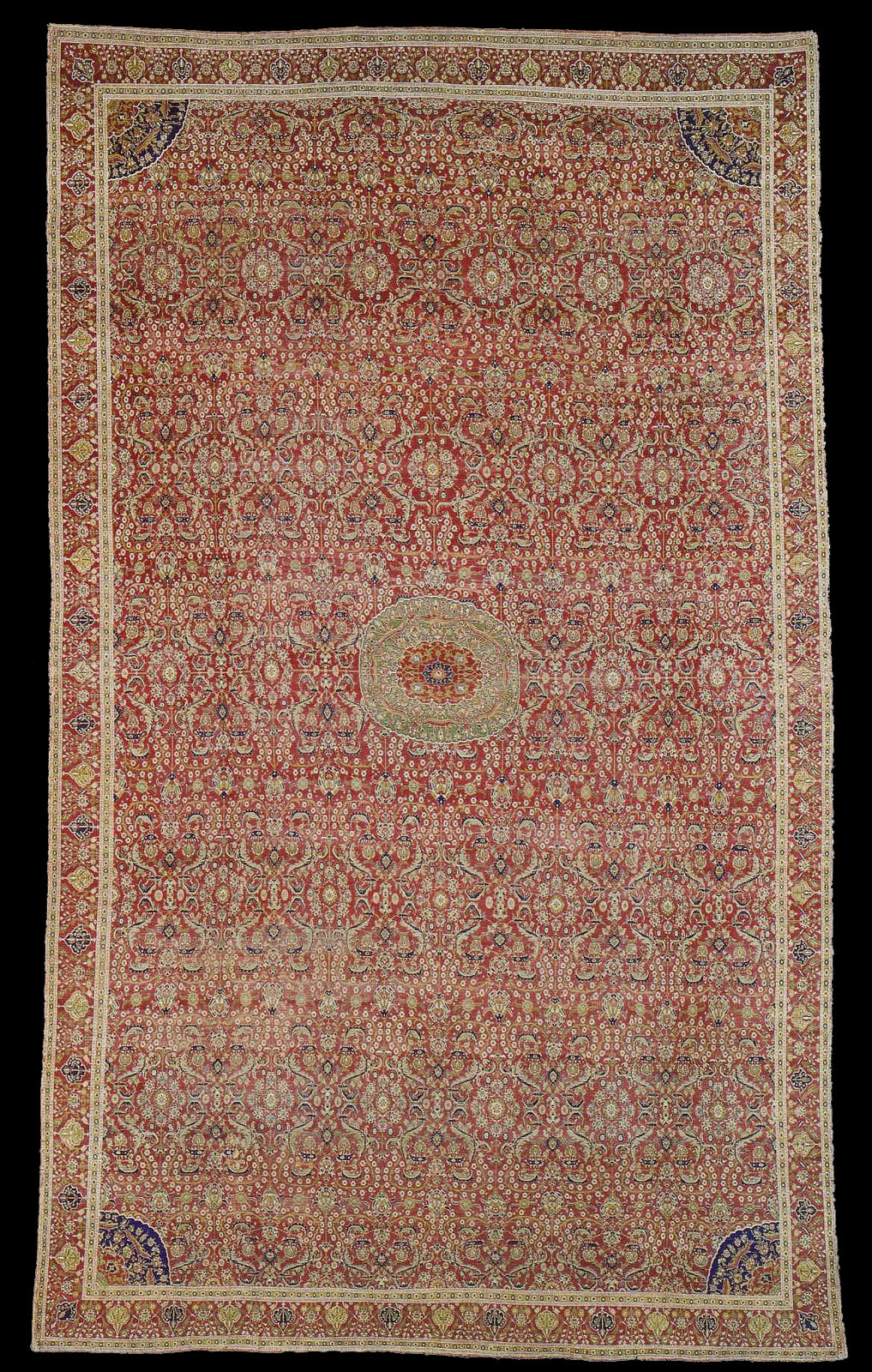TURKISH CARPET: COURT MANUFACTORY; 16th CENTURY
(Formerly in the
Imperial collection) Length, 728 cm.; width, 419 cm.
Warp: yellow
silk, three-fold, left twist. To 1 dm. 134 warp threads (= 33 to the
inch).
Weft: silk, dyed red. After every row of knots two thick
shoots, one straight and one wavy.
Knotting: sheep's-wool and
cotton, two-fold. The white knots are made of cotton. To 1 dm. 48 knots in
the length and 67 in the width (= 12 and 17 to the inch).
Knotted
on two warp-threads. To 1 square dm. about 3200 knots (= 200 to the square
inch). Pile strongly to the left.
Colours: eight. In the inner
field the ground red, the pattern in green, bluish-green, yellow, brown,
while, dark blue, light blue and red. Border-colours: in the middle
stripe, the ground red, the pattern in the same colours as the inner
field; in. the edgings, the ground yellow, in places red; the pattern in
dark blue, white, green. The border is not differentiated in its
colour-scheme from the inner field. The outlines of the pattern of the
whole carpet are in the various colours of the carpet.
State of
preservation: very good. The carpet is only slightly worn. The parts of
the pattern in cotton project, above the worn woollen knots.
The
inner field shows an evenly-distributed all-over pattern. The border cuts
into this pattern at the same point on both sides of the carpet, so as to
render it completely symmetrical. In the true centre of the carpet is an
elliptical medallion of irregularly-lobed outline superimposed upon the
pattern; it is divided into zones with different patterns on grounds of
varying colours. A blossom on a blue ground forms the centre, within an
indented ellipse; the next zone contains radiating arabesques on a red
ground; the third zone is wider, with radiating blossoms springing from
palmettes in groups of three on a green ground. Across the groups down the
middle and along the diagonals lie cloud-motives. Among the flowers,
carnations, roses and tulips may be recognised. In the corners of the
inner field of the carpet are to be seen quadrants of the middle-medallion
with the same patterns but on grounds of other colours — in the following
sequence from the centre, green, red, dark-blue. The pattern of the inner
field is composed of groups of ornament arranged in rows — the groups in
each alternate row being placed diagonally with relation to those in the
two neighbouring rows. The chief motive resembles the lower part of the
pattern of the prayer-carpet reproduced on Plate 56; it consists of an
inter-connected floral composition, the middle line of which is formed by
palmettes arranged one above the other. To right and left of these
palmettes are to be seen, in symmetrical disposition, first two large
curved serrated lancet-leaves, then two stems of rosettes curving away
from one another. This principal motive is turned alternately towards the
different ends of the carpet, so that the whole pattern has no single
direction. Free spaces are left where the design contracts below, and
these are filled with rosettes encircled by eight fringed-palmettes. The
stems which connect these small palmettes with one another form an
eight-pointed star. From this motive straight shoots issue, towards the
ends of the carpet, crowned by palmettes. The rows of these palmettes
turned alternately towards the different ends of the carpet, together with
the rosettes between them (from which lancet-leaves issue on either side)
separate the floral motives above described from one another. In the whole
pattern emphasis is given both to the horizontal and vertical direction.
The middle of the carpet is especially marked by a straight stem running
from side to side.
The relatively-narrow border contains floral
motives turned outwards. The blossoms, alternately enclosed within an
ornamental form and standing free in groups, include roses, carnations,
hyacinths, and tulips. The edgings are decorated with a row of rosettes
and have on either side a strip containing small S-forms. At the ends
patterned woven-borders with silk threads of different colours.
Text: Old Oriental Carpets, issued by the Austrian Museum for Art and
Industy
with text by Friedrich Sarre and Hermann Trenkwald |

